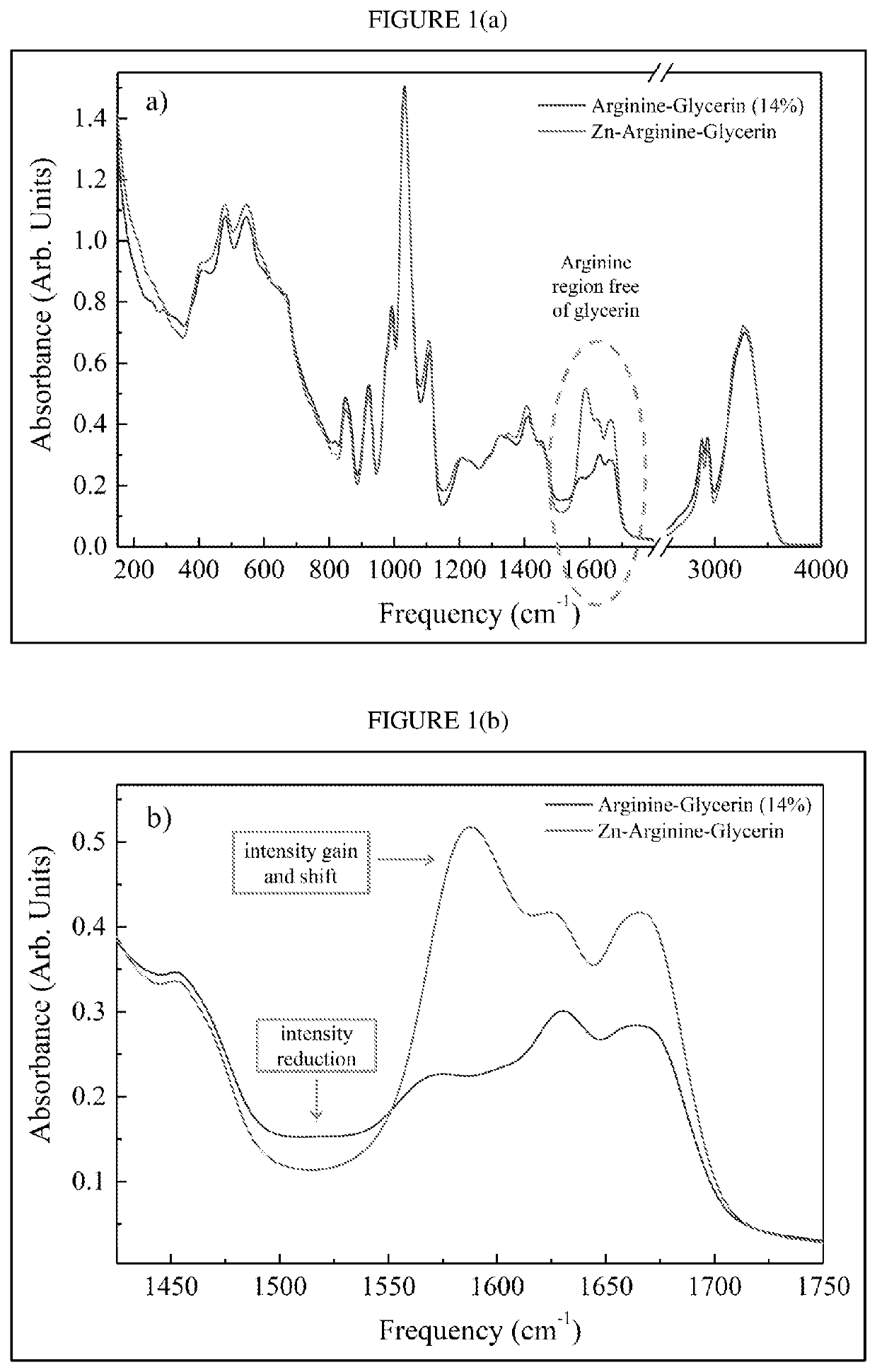Zinc-Arginine-Chloride Complex
a technology of arginine chloride and complex, which is applied in the field of zincarginine chloride complex, can solve the problems of poor taste and mouthfeel, reduced sensitivity of teeth, poor fluoride delivery, etc., and achieves the effects of enhancing the shine of teeth, reducing bacterial colonization and biofilm development, and protecting against erosion
- Summary
- Abstract
- Description
- Claims
- Application Information
AI Technical Summary
Benefits of technology
Problems solved by technology
Method used
Image
Examples
example 1
and Characterization of Anhydrous Liquid ZBA Complex
[0138]The general reaction for formation of ZBA according to this method is as follows:
ZnCl2+2Arginine→[Zn(Arginine)2Cl]+Cl−(ZBA)
Glycerin (400 g) is combined with zinc chloride (48.11 g) and L-arginine free base (123.00 g) in a 2 liter reaction vessel. The mixture is stirred overnight with a mechanical stirrer set to 800 rpm. The theoretical ZBA concentration in glycerin is 30% (w / w) based on the ingredients as-combined. A sample of the resulting mixture is then analyzed using liquid chromatography-mass spectrometry (LC-MS), carbon-13 nuclear magnetic resonance (NMR) spectroscopy, and Fourier-transform infrared (FTIR) spectroscopy, as described further below.
[0139]LC-MS:
[0140]LC-MS analysis is performed using an AB Sciex tandem mass spectrometer (AB Sciex LLC, Framingham, Mass., USA) equipped with an electrospray ionization (ESI) interface and an Agilent 1260 capillary LC system (Agilent Model 1260, Agilent Technologies, Palo Alto,...
example 2
l Efficacy Evaluation
[0151]Wound healing efficacy is determined by incubating a monolayer cell culture with ZBA.
[0152]Briefly, a keratinocyte cell line (Hacat) was cultured with full confluency in a 24 well plate. The cells are then scratched horizontally and vertically with a pipet tips to generate a wound. The cells are washed twice with 1 mL of PBS buffer, then full culture medium (supplemented with 10% FBS and 1% antibiotic) is added to the scratched cells. The ZBA solution obtained from Example 1 is diluted with full culture medium at a concentration of 5 ppm or 50 ppm. Culture wells are incubated at 37° C. at 5% CO2 for up to 72 hours with either the ZBA medium mixture or with medium alone. The area of the scratches is then compared by light microscopy at different time points up to 72 hrs.
[0153]The results show that culture treated with the ZBA solution of Example 1 produces greater cell migration and faster proliferation compared to medium alone. In addition, in the presence...
PUM
| Property | Measurement | Unit |
|---|---|---|
| average particle size | aaaaa | aaaaa |
| average particle size | aaaaa | aaaaa |
| particle size | aaaaa | aaaaa |
Abstract
Description
Claims
Application Information
 Login to View More
Login to View More - R&D
- Intellectual Property
- Life Sciences
- Materials
- Tech Scout
- Unparalleled Data Quality
- Higher Quality Content
- 60% Fewer Hallucinations
Browse by: Latest US Patents, China's latest patents, Technical Efficacy Thesaurus, Application Domain, Technology Topic, Popular Technical Reports.
© 2025 PatSnap. All rights reserved.Legal|Privacy policy|Modern Slavery Act Transparency Statement|Sitemap|About US| Contact US: help@patsnap.com

